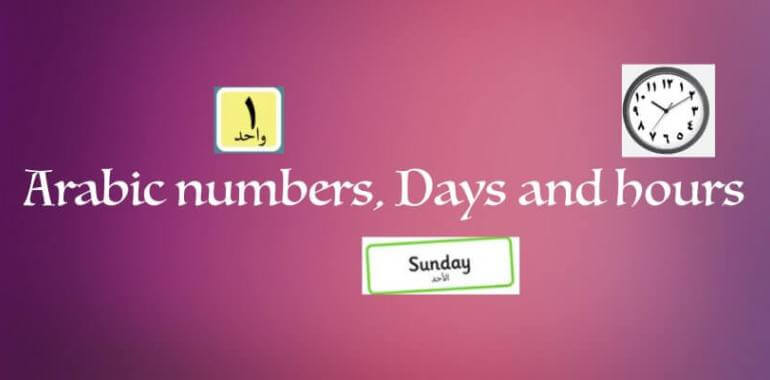Arabic Numbers Days and Hours (English to Arabic)
Indians invented the number system, while the Arabs added a zero to it. Imagine the number system without a zero, and you would realise that it is extremely hard to count the numbers without having the iterative power of zero!
Numbers are considered to be the most elementary pieces of information. Numbers play an important role in everyday life. Not knowing the number system is a huge setback if you are in a foreign country, so it is always advisable to know the basics to start with. This is the foundation of the the Arabic Counting System.
The Arabic Number System
- Zero – Sifr (صفر)
- One – Wahid (واحد)
- Two – Isnayn (إثنين)
- Three – Salasa (ثلاثة)
- Four – Araba’ (أربعة)
- Five – Khamsa (خمسة)
- Six – Sitta (ستة)
- Seven – Sab’a (سبعة)
- Eight – Samaniya (ثمانية)
- Nine – Tisa’ (تسعة)
- Ten – Ashara (عشرة)
- Eleven – Ihda Ashar (أحد عشر)
- Twelve – Isna Ashar (اثني عشر)
- Thirteen – Salasa Ashar (ثلاثة عشر)
- Fourteen – Arab’a Ashar (أربعة عشرة)
- Fifteen – Khamsa Ashar (خمسة عشر)
- Twenty – Ashroon (عشرون)
- Twenty One – Wahid Wa Ashreen (واحد وعشرين)
- Twenty Two – Ithnayn Wa Ashroon (اثنين و عشرون)
- Thirty – Thalathoon (ثلاثون)
- Fourty – Araba’oon (أربعون)
- Fifty – Khamseen (خمسون)
- Sixty – Sittoon (ستون)
- Seventy – Sab’oon (سبعون)
- Eighty – Thimaneen (ثمانون)
- Ninety – Tis’een (تسعين)
- One Hundred – Miah (مائة)
- One hundred and Fify One – Maya wa Khamseen Wahid (مائة وخمسين واحد)
- Two Hundred – Miatain (مائتين)
- Three Hundred – Salasa Miah (ثلاثمائه)
- One Thousand – Alf (ألف)
- One Thousand Two Hundred – Alf wa Miatain (الف ومئتان)
The Pattern in Arabic Numbers
You can easily find the pattern that each of the numbers follow. You need to remember the numbers from one to twenty, and then you can construct any number through it. For Example: Thirty is Salaseen, and Five is Khamsa. So 35 becomes: Khamsa Wa Salaseen
The Days in Arabic
The Arabic days are based on the the number system as well. It starts from Sunday which is given the number zero, and the counting continues till Thursday which is given the number Five. Ahad, Ithnayn, Salasa, Arab’a, and Khamees are 1,2,3,4 and 5 respectively. While Friday and Saturday have different names – Jumu’a and Sabt respectively.
- Sunday – Yaom Al Ahad (يوم الأحد)
- Monday – Yaom Al Ithnayn (يوم الإثنين)
- Tuesday – Yaoma Al Salasa (يوم الثلاثة)
- Wednesday – Yaoma Al Arba’a (يوم الأربعة)
- Thursday – Yaom Al Khamees (يوم الخميس)
- Friday – Yaom Al Jumu’a (يوم الجمعة)
- Saturday – Yaom Al Sabt (يوم الثبت)
The Hours in Arabic
Keeping time is also an important aspect of our daily life. The clock and timekeeping measures in Arabic are:
- Day – Yaom (يوم)
- Week – Usboo’ (أسبوع)
- Hour – Sa’a (ساعة)
- Minute – Daqiqa (دقيقة)
- Second – Saniya (ثانية)
- O’Clock – As Sa’ah
- Year – Sanah (سنة)
- Yesterday – Ams (أمس)
- Tomorrow – Ghadan (غداً)
In this lesson we have learned about the Arabic Numbers, Days and Hours. You can use this lesson as a guide to remember and recall most of what you need to understand the timekeeping and numbering system. If You are going out for dinner, you can read our previous blog. You can also follow our blog to get regular updates and learn Arabic.
At SAIOI, We provide private Arabic Lessons on Skype. If you apply now, you will also get the first lesson for free!!




